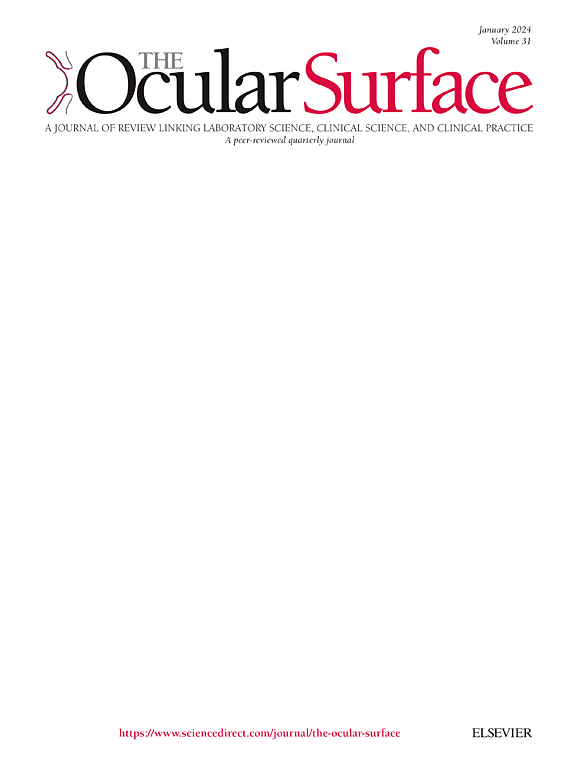Smoking negatively impacts ocular surface health and corneal nerve metrics
IF 5.6
1区 医学
Q1 OPHTHALMOLOGY
引用次数: 0
Abstract
Purpose
To evaluate the effects of smoking on ocular surface through comprehensive analysis of corneal nerves, corneal epithelium, dendritic cells (DCs), and clinical assessments.
Methods
This cross-sectional study included 250 healthy smokers and 272 healthy non-smokers. Patients’ smoking status and duration were recorded. In vivo confocal microscopy was performed to assess 7 quantitative corneal nerves parameters, 3 corneal neuroma parameters, 3 DCs parameters, and 3 epithelial parameters. Ocular surface evaluations included tear break-up time (TBUT), ocular surface and corneal staining, corneal sensitivity, and Schirmer test. Ocular Surface Disease Index questionnaire was used for symptom assessment.
Results
Compared to non-smokers, smokers exhibited significantly lower corneal nerve fiber density (CNFD), nerve branch density, nerve fiber length, nerve total branch density, corneal nerve fiber area (CNFA), and corneal nerve fractal dimension (CFracDim; all p < 0.001). Smokers also presented with a significantly swollen corneal nerve fiber (p < 0.001). Longer smoking duration was significantly associated with lower CNFD (β = −0.04, P = 0.010), lower CNFA (β = −0.00002, P = 0.033), and lower CFracDim (β = −0.0008, P = 0.016). Additionally, a significantly larger neuroma total area (p = 0.040), size (p < 0.001) and perimeter (p < 0.001), as well as a significantly higher DCs density (p < 0.001), DCs count (p = 0.003), and lower DCs elongation which suggested higher DCs maturity (p < 0.001), were observed in the smoking group. Smokers demonstrated significantly higher ocular surface staining scores (p < 0.001) and reduced TBUT (p = 0.001). Corneal epithelial circularity was borderline higher in the smoking subjects (p = 0.059).
Conclusions
Smoking is associated with significant alterations in corneal nerve morphology and quantity, increased immunological cells, and compromised ocular surface integrity.
吸烟对眼表健康和角膜神经指标有负面影响。
目的:通过对角膜神经、角膜上皮、树突状细胞(dc)的综合分析和临床评价,评价吸烟对眼表的影响。方法:本横断面研究纳入250名健康吸烟者和272名健康非吸烟者。记录患者吸烟状况及持续时间。采用体内共聚焦显微镜评估7个定量角膜神经参数、3个角膜神经瘤参数、3个dc参数和3个上皮参数。眼表评价包括泪液破裂时间(TBUT)、眼表及角膜染色、角膜敏感性、Schirmer试验。采用眼表疾病指数问卷进行症状评估。结果:与非吸烟者相比,吸烟者的角膜神经纤维密度(CNFD)、神经分支密度、神经纤维长度、神经总分支密度、角膜神经纤维面积(CNFA)和角膜神经分形维数(CFracDim;结论:吸烟与角膜神经形态和数量的显著改变、免疫细胞增加和眼表完整性受损有关。
本文章由计算机程序翻译,如有差异,请以英文原文为准。
求助全文
约1分钟内获得全文
求助全文
来源期刊

Ocular Surface
医学-眼科学
CiteScore
11.60
自引率
14.10%
发文量
97
审稿时长
39 days
期刊介绍:
The Ocular Surface, a quarterly, a peer-reviewed journal, is an authoritative resource that integrates and interprets major findings in diverse fields related to the ocular surface, including ophthalmology, optometry, genetics, molecular biology, pharmacology, immunology, infectious disease, and epidemiology. Its critical review articles cover the most current knowledge on medical and surgical management of ocular surface pathology, new understandings of ocular surface physiology, the meaning of recent discoveries on how the ocular surface responds to injury and disease, and updates on drug and device development. The journal also publishes select original research reports and articles describing cutting-edge techniques and technology in the field.
Benefits to authors
We also provide many author benefits, such as free PDFs, a liberal copyright policy, special discounts on Elsevier publications and much more. Please click here for more information on our author services.
Please see our Guide for Authors for information on article submission. If you require any further information or help, please visit our Support Center
 求助内容:
求助内容: 应助结果提醒方式:
应助结果提醒方式:


